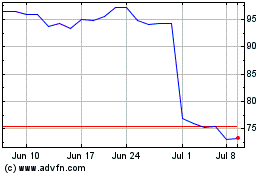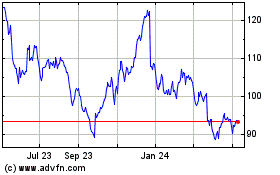Nike Squeezed by Rivals, Old and New, as Athleisure Spreads
September 28 2016 - 5:26PM
Dow Jones News
By Sara Germano
The Olympics may be over, but Nike Inc.'s competition is just
heating up.
For years, Nike has held the dominant position as the world's
largest sportswear maker. But results from the company's latest
quarter, released Tuesday, fanned some fears that Nike's
stranglehold on the athletic apparel and footwear market could
slip.
Lower than expected orders from wholesale partners, along with
recent retail data which shows Under Armour Inc. and Adidas AG
gaining share in key categories, as well as a broad influx of
upstart athletic brands all combined to send rattles through the
market about Nike's progress.
The company reported fiscal first-quarter revenue and earnings
growth, but fell below Wall Street's expectations on future
wholesale orders and gross margins. Several brokerage analysts
downgraded their price targets on Nike's stock, which closed down
3.8% at $53.25 on Wednesday. The shares are now down 15% on the
year.
Among those lowering their targets were Credit Suisse analysts,
who wrote early Wednesday that "we are becoming increasingly
concerned that the quality of results is deteriorating, as top-line
trends in key markets look shaky, gross margin pressure is
persistent, and the company is reducing disclosure."
Nike executives acknowledged Tuesday they faced increasing
competition but said growth in the sportswear and footwear markets
continues to outpace the global economy. "It's a great time to be
in the business of sports and as the market leader, this is a great
time to be Nike," CEO Mark Parker said on a conference call.
New research shows the strength of the so-called athleisure
market, broadly referring to clothes and shoes intended for fashion
rather than sport. For the year through August, less than one-third
of activewear sales were intended for actual athletic activity, the
lowest such proportion in four years, according to consumer
tracking firm NPD Group.
"Because activewear is so broadly used, available, and defined
by the sports and fashion industries, some of the bigger, authentic
brands are feeling pressure," said NPD analyst Matt Powell. On the
low end, Nike is competing with mass-market chains such as Old Navy
that sell $15 yoga pants, while Savile Row tailors are now making
bespoke tracksuits.
A Nike spokesman said the company's relationships with elite
athletes as well as insight to consumer trends helps it create
products that appeal "to a wide audience, while also infusing
sportswear with performance benefits."
Jay Sole, an analyst for Morgan Stanley, said it's "an open, and
very important question" as to whether Nike can stop rival Adidas
from taking share in the casual category, which has been driving
growth in the overall athletic sector. "Lately [Adidas's] efforts
have been more successful and the new stuff hitting stores for
holiday may continue to beat Nike's despite best efforts," he
said.
Meanwhile, Under Armour has begun selling high-end athletic gear
at Barneys New York and has announced plans to stock shelves at
Kohl's Corp. stores beginning early next year. Both retailers have
been important Nike accounts.
Nike, for its part, has been working to separate itself from the
pack. The company is betting it can expand its direct sales to $16
billion by 2020, or roughly a third of revenue, lessening its
reliance on wholesale partners. In the fiscal year ended May 31,
direct-to-consumer revenue was $7.8 billion, or roughly 25%, of
Nike brand revenue.
To underscore those efforts, Nike said Tuesday it would change
the way it reports wholesale orders. Chief Financial Officer Andy
Campion said the company would limit its reporting of so-called
futures orders -- which measures growth in shipments due to
wholesale partners over the next six months -- to guidance on
earnings calls and details in its regulatory filings.
Nike has also worked to develop products that appeal to both
workout junkies and the athleisure crowd. On Tuesday, Mr. Parker
called out the company's newly released LunarEpic running shoe,
which he said "is also translating extremely well to a style
audience and it's selling through well beyond expectations."
Write to Sara Germano at sara.germano@wsj.com
(END) Dow Jones Newswires
September 28, 2016 17:11 ET (21:11 GMT)
Copyright (c) 2016 Dow Jones & Company, Inc.
Nike (NYSE:NKE)
Historical Stock Chart
From Mar 2024 to Apr 2024

Nike (NYSE:NKE)
Historical Stock Chart
From Apr 2023 to Apr 2024
